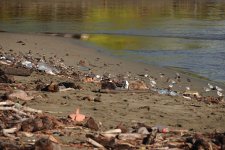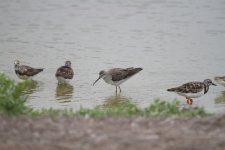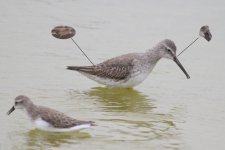For comparison, here are two photos of Stilt Sandpipers in the company of Turnstones and a Semipalmated Sandpiper.
Note how body size is similar to that of Turnstone and much bigger than that of SemiP.
On that basis alone, Stilt Sandpiper can be completely discarded as an option here.
If that in itself is not convincing enough for some readers, there are several other helpful features:
In all plumages, Stilt shows a characteristic protrusion of white feathers on the base of the lower mandible; it also shows a more prominently streaked throat and narrower white eyering (behind the eye). Also, note the shape and pattern of the greater coverts: the OP bird is a first winter, just like the two Stilt Sandpipers attached here; the juvenile greater coverts are more oval-shaped in the latter and show a distinct, blackish anchor pattern near the tip. The OP bird has narrow, pointed greater coverts with just a blackish shaft streak, no anchor.
View attachment 1492732View attachment 1492733











